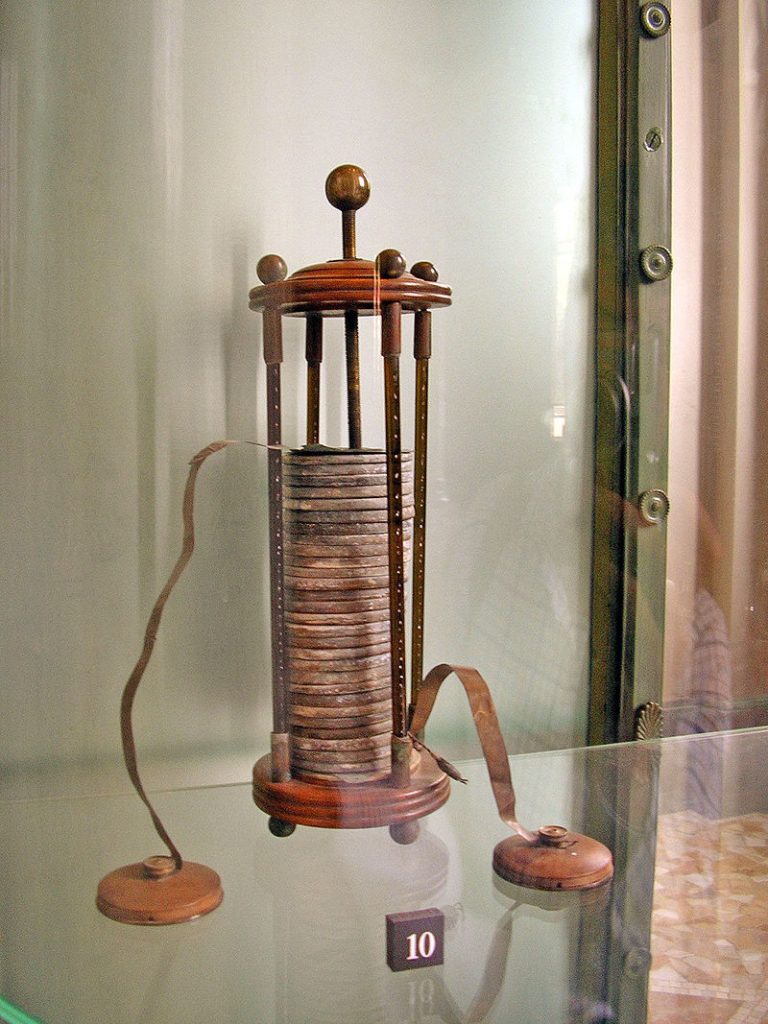Can you imagine a day without a battery? All our devices from smartphones to pacemakers use the power of batteries to harness electricity. These devices play a pivotal role in our society and it is important to give credit where credit is due. You can thank the great Italian scientist Alessandro Volta for his discovery of the first ever battery coined the voltaic pile. If his name sounds a bit familiar it is because the volt (unit for electric potential) is named after him.

Alessandro Volta was born to an aristocratic family in Como, Italy on February 18th, 1745.1 Volta excelled in math and science at a very young age. Even as a school boy he showed a keen interest in electricity. In the eighteenth century, the phenomenon of electricity was an intellectual curiosity, and not much was known about its properties. Volta excelled in school, and in 1774 he became a professor of physics at the Royal School of Como.2 During his time as professor, his interest in electricity remained a focus of his work. He created the electrophorus, which was a device used to generate static electricity.
Volta never set out to invent the battery. His experiments on electricity were in response to the claims of a scientist and friend of his, who claimed to have found electricity in animals.3 This scientist was Luigi Galvani, a professor of anatomy at the University of Bologna. One day as Galvani was performing an experiment on frogs, he began to cut the legs so that they would be exposed. When he touched his steel scalpel with a brass hook holding the frog’s legs in place, he saw the legs twitch. Galvani was convinced that what was going on was the presence of animal electricity. Galvani thought the muscles of the frog stored its life force. When Volta learned about Galvani’s discovery of animal electricity, he went right away to try to replicate Galvani’s experiment. Volta wanted to see for his own eyes what Galvani had published to the scientific community about his new discovery. After completing the experiment dozens of times, Volta disagreed with Galvani. Volta believed that the movement of the frog legs were because of the electric stimulation that was provided by the steel scalpel and the brass hook.4 Volta concluded that the frog’s legs were merely a vessel for the electric stimulation.

Once Volta recreated Galvani’s experiment, he knew the key to producing electricity was by using two metals that were not the same and not the actual frog legs themselves. The frog legs could not produce any sort of electricity. The reason the frog legs would move was because of the charge which was sent through the frog legs and into the nerves inside the legs which in turn resulted in a twitch. This was an indication that electricity was present. Volta recreated the experiment but would later conclude the frog legs were not the only electricity indicators but so were other materials such as moist cards of brine, or cardboard soaked in salt water. This was when Galvani concluded that the electric charge came from the rods of metal themselves and had nothing to do with frog legs. For the first experiment he used five cups with brine or salt water in them. Then, by adding pieces of silver and zinc, he attached the cups by metal strips where he placed them into the cups of brine. He would then put one finger at each end of the cups to feel the slight electric shock. Impressed with his work, he wanted to see if he could recreate his experiment, but without all the brine water. He then created a circuit consisting of copper and zinc discs that were separated by a cardboard soaked in brine. Just by adding more copper, cardboard soaked in brine, and zinc, Volta was able to adjust the amount of electricity that was being produced by the circuit. This became the voltaic pile, the first battery with a reliable source of electricity. Once Volta realized what he had done, he was able to refute the idea Galvani proposed about animal electricity.

Volta published his experiment and findings to the scientific community and later was honored for his invention of the voltaic pile. Today it is now almost impossible to not be in constant contact with a battery. You can thank Alessandro Volta for his discovery of the battery, which became a template for our modern dry-cell batteries. We might also thank Luigi Galvani for his role in stimulating Volta’s experiments, and maybe even thank the many nameless frogs for their contributions.
- Oliver J. Thatcher, The Library of Original Sources (New York, Chicago: University Research Extension, 1907), 395. ↵
- Encyclopedia of World Biography, 2004, s.v. “Alessandro Volta,” by Paula K. Byers. ↵
- Joost Mertens, “Shocks and Sparks: The Voltaic Pile as a Demonstration Device,” The History of Science Society 89, no. 2 (June 1998): 303. ↵
- Giuliano Pancaldi, Volta: Science and Culture in the Age of Enlightenment (Princeton University Press, May 1, 2005), 110. ↵



51 comments
Samman Tyata
I found your article really impressive. The details about the work are effectively and efficiently described. Furthermore, i kind of liked the way how you described about the background of Alessandro Volta. This article has successfully helped me to learn more about the batteries and how they are produced. Also, i found the experiments of Luigi Galvani interesting as well. I agree that batteries are one of the most important things in human life. To sum it up, it was an informative and good read.
Ryann Cervantes
Great read. I’ve always thought of someone like Nikola Tesla as a really underappreciated and unknown scientist, but never did I stop and ask, “Who invented the battery?” Now I want to look up who else invented the basis for common appliances I take for granted and I can add Volta to the list of people to thank everyday for what I have.
Matthew Rios
I never actually knew who had invented the battery until now, but it was to my understanding that many scientific units of measurement are named after someone. It’s always fascinating to see how these ideas come to fruition. I enjoy seeing the people of our past coming up with such innovations. One must wonder what more people could accomplish nowadays if they weren’t so preoccupied with other trivial aspects of life.
Valeria Hernandez
Cameron Ramirez provides readers with interesting facts regarding the history of electricity. The article is informative and interesting as our world revolves around the use of electricity. It is wonderful to learn about the history of one of the greatest and most influential inventions in human history. Ramirez executes the description of the battery in an objective yet fascinating tone. The article is clear and conveys a clear idea.
Alexis Soto
Great article regarding Volta’s Battery, it was enjoyable to read. In all honesty, I had no idea who had invented the battery, despite it being a significant technological adaption in recent times. Thanks to your article I now know that Italian scientist, Alessandro Volta, discovered and coined the first battery, voltaic pile. More interestingly, how frogs were a crucial factor in the battery’s discovery.
Carlos Aparicio
It’s true that batteries are a huge part of our day because we use our phones every single day and we need batteries to charge them at night for the next days use. I never knew how the battery came to exist or who invented it. Alessandro Volta is a hero in my book because he made a revolutionary discovery that the world needs extremely. I love this topic because I was very interested from the start.
Thomas Fraire
I did not know who created the batterie and I definitely didn’t know who Volta was. It’ crazy how he was doing all these awful tests on frogs, which just lead to him discovering and incredibly important discovery. This article flowed so smoothly and it didn’t feel like a bibliography I really liked how you zeroed in on these experiments and told the story through them.
Michael Mandujano
After reading this article I gained a greater understanding how the first batteries created. I really enjoyed the images that were depicted throughout the article. In fact, it is quite interesting that frog legs were used to power the first batteries. Overall, it is phenomenal that Alessandro Volta invented the first battery and was recognized by naming charges “volts.”
Osman Rodriguez
Extremely interesting article! I knew of Alessandro Volta myself, but did not know of this important fact. Technically, we do have small electrical pulses that run through our body, but I can see where Galvani is mistaken. The legs where able to act as a way for the electricity to travel, but they do not produce it themselves or store it. Almost every piece of technology we use today, requires or contains a battery. You’re right, it is important we pay homage to Volta, Galvani, and the many frog legs.
Amanda Figueroa
This article caught my attention because I realized I never knew how the battery was invented. The title is really what drew my attention to this article. It’s funny to think that Galvani had believed in animal electricity, but their curiosity and motivation to conduct such experiments is fascinating. There hasn’t been any new major inventions lately and I think it’s because we’ve lost our curiosity and drive to finding new things.